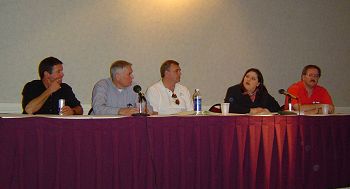|
Private
Space - Getting Real
At Space Acess ' 03 no one revealed an orbital rocketship, a space
hotel under construction, or anything else so dramatic. However,
of the six conferences that I've attended this one gave me the strongest
sense that real stuff is happening and not just viewgraph dreaming.
Real hardware is getting built, real honest-to-God rocket vehicles
will soon start flying to high altitudes, and people are going to
spend real money for rides for themselves and for their payloads.
It will be many years before the startups reach the orbital highway
but they have found the on-ramp and just need to keep moving along
it one small step at a time.
The suborbital
ramp has clearly become the focus of private space access efforts.
Several talks dealt with projects to build crewed vehicles for routine
access to altitudes from 50 to 100 km. Very few talks dealt with
orbital access or operations. The FAA is also thinking a lot about
suborbitals and the representatives at the meeting revealed the
new official definition of a suborbital vehicle (see Jeff Foust's
RLV
regulation: licensing vs. certification The Space Review - Apr.28.03),
which took several months to develop.
Burt Rutan did
not show up but the recent debut of the SS1
certainly gave a boost to the morale of everyone, even to those
in competition with him for the X PRIZE. His involvement in private
space development puts the whole industry into the spotlight and
opens doors to new sources of funding. The announcement over the
weekend that Jeff Bezos of Amazon.com has his own suborbital
rocket project only added to the sense that a wave of space
development is building and that this time it is sustainable.
Ten
Years Working for CATS
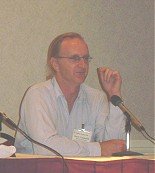
Henry Vanderbilt
As he has since the first meeting in 1993, Henry Vanderbilt did
a great job with the organization of the meeting and in gathering
a fascinating array of speakers. In thanks for ten years of working
to support cheap access to space, Henry Spencer and XCOR treated
Mr. Vanderbilt to a fine set of vintage rocketry and space books
and a couple of very large and tasty cakes that we all enjoyed.
Presentation Synopses
I give here brief summaries of most of the presentations. I've
divided them into three rough categories :
Hardware
XCOR
- Dan Delong and Aleta Jackson reviewed the history of XCOR and
the successful EZ-Rocket
project. They recently obtained funding
for development of their piston fuel pump and they moved
to a much larger building on the Mojave Airport grounds.
Development
of the Xerus
two seater rocketplane is coming along but full funding has not
yet been obtained. (Ed Wright, see below,
revealed that XCOR will build the lower altitude Archangel
if that project is funded and the Xerus is not.)
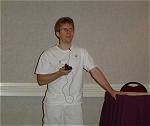
John Carmack
of Armadillo
Aerospace
Armadillo
Aerospace - John Carmack opened his presentation
with another hilarious animation (available on the AA
homepage.) He then discussed progress and setbacks in the previous
year and plans for the near and far term.
The short
flight of Russ Blink last September was a milestone in their
development of their vertical takoff, vertical landing vehicles.
Major components for the full sized X PRIZE vehicle have been built
and testing has begun including drop tests of the crush cone top.
A sub-scale version has begun short tethered flight tests.
However, there were significant problems with companies refusing
to deal with them due to liability concerns. Two parachute firms
would not sell to them and two hydrogen peroxide suppliers so far
have refused to provide them with the high purity H2O2 needed for
their primary propulsion system. They have a bi-propellant backup
scheme but they still have hopes of obtaining the H202.
The shortage of peroxide, which has become a problem for many advanced
rocketry projects, forced them to conserve the amount they had on
hand over the past several months and this severely cramped their
"build-a-little, test-a-little" approach. This put them
behind where they expected to be by now. They have begun distilling
their own peroxide but this will only be in quanitities sufficient
for modest flight tests.
The current
X PRIZE design is only meant for winning the contest and not for
practical applications such as suborbital tourism. The occupants
will take off facing backwards, for example, so that they will be
facing upwards when they land (which will produce much stronger
g forces.) There is no window in the vehicle. To save weight their
will be no fins on the vehicle and instead it will be dynamically
stabilized via control of the 4 engines.
The project
has cost him about half a million dollars so far [$150,000 in year
1, $300,000 in year 2, and at least $50,000 so far this year]. After
the X PRIZE they will concentrate on vertical takeoff, powered vertical
landing vehicles. [Corrections
May.1.03]
TGV
Rockets - Pat Bahn would not explicitly state that
the company has obtained funding but he did say they are now taking
deposits (with penalty payments if they don't deliver) for flights
in 2006. The piloted MICHELLE-B
VTVL vehicle will take 1000 kg to 100km and back. Their main markets
include imaging for remote sensing and reconaissance, missile defense
test targets, and scientific experiments.
Rocket
Guy definitely gave by general acclaim the most entertaining
presentation . The affable Brian Walker recounted his experiences
and preparations over the past few years since he first announced
his intention to launch himself to 30 miles in his own homebuilt
rocket. Using money obtained from his toy designs licensed to Disney
and other companies, he has built a wide array of support facilities,
such as a centrifuge capable of 8g tests, and an impressive mobile
launch platform with a compressed-air system for getting his vehicle
off to a flying start. (I later heard some other rocket builders
saying they would look into such a booster for their vehicles.)
His vehicle
will use hydrogen peroxide engines built by [Arvil Porter, who has
made rocket motors for dragsters] and he is also distilling his
own fuel supply [with a system from Tecnología
Aeroespacial Mexicana.] [Corrections
May.1.03]
X
Rocket - Ed Wright described a Rocket Academy
adventure tourism project in which participants would spend two
weeks using simulators and undergoing various training experiences,
culminating in a ride to 50 km in an Archangel. XCOR is designing
the two seater rocket vehicle, which takes off and lands horizontally.
The flight with a pilot and one passenger would take about 17min.
The vehicle could also be use for flight training and education.
An external hardpoint, for example, could carry scientific payloads.
The design has
now matured to the point that they will now start looking for funding
and could be flying two years after its availability. If the higher
altitude Xerus is funded separately, then they will use it instead.
Len
Cormier discussed his "Bear Cub" system
in which a Russian Tupelev Tu-95 Bear Bomber would carry a two staged
winged rocket vehicle. The 2-staged system with a winged vehicle
could send a pilot and 450kg to LEO.
He also briefly
discussed his X
PRIZE entry, which previously used a Sabre-40 jet airframe but
now is based on a LearJet vehicle. Microcosm
engines would provide the boost.
Other
Launchers:
- Pat
Kelly of Vela
Technology presented designs for an air launched suborbital
carried by a large powered soft wing system such as a parafoil,
sail wing or Kite Ship. Though they move farily slowly, such systems
could carry a payload rom 10 to 2000 tons to high altitude.
- Wes
Kelly of Triton Systems discussed his Stellar-J winged
horizontal takeoff and landing vehicle. It could serve suborbital
markets or orbital when combined with a second stage.
- Jordin
Kare presented the latest on laser
launch technologies. A major conference
occurred last November in Huntsville, Alabama where work going
on around the world was presented. A number of university groups
are now concentrating on laser propulsion such as the group in
Huntsville.
Laser ablation is the most popular approach. Kare, however, has
developed a heat exchanger approach in which a laser heats up
a plate with microchannels through which hydrogen flows. Such
a system is calculated to provide an ISP of 600s. He believes
a $2 billion system with arrays of lasers could send a stream
of 100kg payloads to orbit.
Advanced
Rocketry:
- Flometrics
chief Steve Harrington discussed his company's innovative pistonless
dual chamber rocket
fuel pump, which they plan to do a static test on soon and
later fly on their sounding
rockets. The pump is about two orders of magnitude cheaper
than a turbopump but provides similar performance, weighs less,
and has no catastrophic failure modes. It is scalable to large
systems and allows for redundant systems.
- ERPS
members Michael Wallis, Dave Masten and Sean Lynch discussed the
various projects
of the group including flights of the KISS (Keep It Simple Stupid)
rocket, the small POGO vertical takeoff and landing (ala DC-X)
vehicle, and a plug nozzle engine design. They also have peroxide
supply problems and have begun producing their own.
- Jonathan
Goff presented his work on a coaxial pintle injector
as part of his graduate work in production optimization techniques
and "mass customization".
Markets,
Companies & Funding
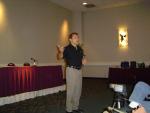
Peter Diamandis
of the X PRIZE and ZERO-G
corporation.
Peter
Diamandis presented the status of the Zero
Gravity Corporation, which this summer will begin offering rides
on airplanes flying parabolic trajectories with up to 25 to 30 seconds
of microgravity per parabola. The company will rent planes and pilots
from an air cargo company. Air cargo planes normally do not fly
during the day so this works out well for both services (ZERO-G
actually received a business patent for this approach.) The project
first started informally nearly 10 years ago and much of the effort
since then went into overcoming regulatory challenges. It took over
3 years to obtain the necessary FAA "Supplemental Type Certificate".
Each flight
can carry up to 25 passengers and 5 trainers and will provide about
20 parabolas. The initial set of 5 or so parabolas will provide
Mars like gravity. Then the next set will provide lunar like gravity.
The final parabolas will go for high quailty zero Gs. It's hoped
that this stepped approach will reduce motion sickness.
The company
will not sell rides directly to the public but will sell them through
adventure travel companies. (The ticket price should be around $4k.)
They also expect to provide flights for scientific research and
hope to take over all of NASA's parabolic flight duties. An unnamed
movie project has already used 6 flights.
Peter
Diamandis also gave a talk on the X PRIZE. He expects
several teams to do test flights in the coming year and doesn't
believe Burt Rutan has the competition all sewn up.
The struggle
to fund the full prize money was quite tough and led to the insurance
policy approach that sets a deadline of January 2005. This kind
of deal is referred to as a hole-in-one policy as it is like
a bet on a hole-in-one occuring during a golf tournament. Apparently,
the company involved does aerospace insurance and will not be terribly
unhappy to lose the purse if it results in selling policies later
to lots of new RLV companies.
Peter indicated
that a follow-on contest might involve a "down range distance"
competition. Also, there could be a yearly X PRIZE Cup get together
in which vehicles would compete head to head.
TOSPACE
chief Laurie Wiggins presented her company's business of sending
memorabilia, sci-fi paraphernalia, and other items to space and
back to enhance their value. They already have several customers
and TOSPACE is actively seeking rides both to orbit and to 100km
suborbital. They will pay up fo $2000 per kg for certified rides
over 100km high. (This definitely made a stir with the launch people
at the meeting!)
ExoTerra
was described by Terrance Yen as a non-profit organization that
will sponsor a credit card whose commissions will go into a fund
dedicated to supporting launch and space companies. Holders of the
cards will vote via the web on what projects the funding will support.
Jess
Sponable was a top Air Force manager for the DC-X
project and retired from the service a few years ago. He is now
back working as a civilian manager for the Air Force at Wright Patternson
AFB in Ohio. He gave an overview of some new programs in the Air
Force dealing with new launch technologies.
The AF is pushing
a program for "responsive, reusable spacelift" development
over the next 20 years. By 2015 they would like to have the capability
of launching a microsat to LEO on a few hours notice. The Pentagon's
new National Aerospace Initiative is also working towards an unmanned
spaceplane, ala X-37/Space
Maneuvering Vehicle, that could fly by 2008 with a 7
day turnaround capability.
Sponable emphasized
that there will be considerable funds available for RLV related
technology development from the AF, DARPA and other sources in the
coming years. Small companies have a good chance to obtain grants
for new ideas.
SpaceDev's
Jim Benson gave an overview of his young company. Their CHIPSat
small scientific satellite flew successfully this year and they
won an Air Force contract for developing a space tug that would
use the hybrid propulsion systems they have been developing based
on technology from the old AMROC company.
The most exciting
news, of course, for SpaceDev is their competition for the contract
to provide the motor to power Rutan's SpaceShipOne. See the images
and videos of a firing of the SpaceDev motor.
RLVs
& Orbital Assembly - Dave Salt gave an update on
his study of the business case for using relatively small RLVs (4
to 5 tons to LEO) to serve the GEO comsat market. In the scheme
he looked at, the RLV would use 3 or more flights to deliver a small
tug and fuel for it to LEO and then with the final flight bring
up the comsat empty of fuel. After rendezvous with the tug, the
comsat would obtain its station keeping fuel and then be taken to
GEO orbit by the tug.
If such a RLV
and tug (like the one under development by Orbital
Recovery) could be built for around $1 billion and if the system
could capture 40% or more of the yearly GEO comsat market, the business
case closes with a hefty profit.
Regulations
for Private RLVs
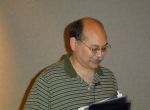
Pat Bahn of TGV
Rockets & the Suborbital Institute
Jeff Foust has
already posted an excellent summary of the situation with RLV regulations
and the discussions during the meeting: RLV
regulation: licensing vs. certification- The Space Review - Apr.28.03.
The issues came
up not only in the panel discussion with the two representatives
from the FAA's Commercial
Space Transportation office (see the top photo) but repeatedly
during the meeting. This says something about how close companies
are to flying.
Updates
May
1, 03 - Steve Harrington corrected me: it's Flometrics
not Flowmetrics.
And they will be doing a static test of the pump before the sounding
rocket tests.
John Carmack
says he has spent "about half a million" instead of the million
that I originally wrote. The spending rate has been "$150,000
in year 1, $300,000 in year 2, and at least $50,000 so far this
year."
He also informed
me that "Brian Walker's engines are made by Arvil Porter, an
old rocket dragster guy, not Juan Lozano, who made the still he
is using" and
that the "ToSpace offer is only for 100km flights, not 50km."
May
7, 03 - Leonard David's review : Rocketeers:
Setting Their Sights on Suborbital Flights - Space.com - May.7.03
May
14, 03 - Jeff Foust's review : The
fifth stage of the RLV grieving process by Jeff Foust - The Space
Review - May.14.03
|



